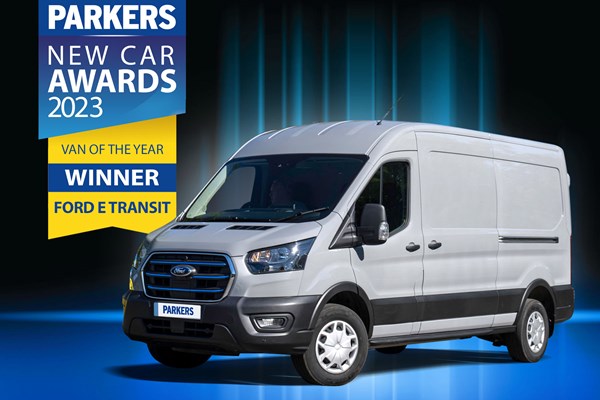Ford E-Transit electric van review (2025)
Ford's large van manages to integrate electric almost seamlessly
PROS
- Built to same quality as diesel Transits
- Very powerful motors
- Driving range boosted with Enhanced Range model
- Quiet, comfortable, great to drive
- Competitively priced
CONS
- Still more than diesel to buy outright
- Electric range not as good as rivals
- Towing weights aren't that great
- Doesn't have the same modern EV feel as Transit Custom
- Payload not up to competition offering
Summary
The Ford E-Transit is everything you would hope for – a superb large electric van from the UK and Europe’s bestselling light commercial vehicle manufacturer.
Like all other large electric vans, the 2025 Ford E-Transit is based on the same basic platform as the equivalent diesel model and it is a conversion rather than a ground-up purpose-built eV. The difference between the Ford and many of its rivals that are also conversions is in the quality of the electric transformation, the capability – meaning the driving range and the performance – and the price.
The E-Transit started life being considerably cheaper than its competition as well as being significantly better, but price rises since launch and the arrival of more keenly priced and excellent rivals (primarily the Renault Master E-Tech) mean that it no longer has the better of all of its peers. That said, it is still very much one of the best out there and it also offers tangible advantages over the diesel Transit, which might give any large van buyer reason to pause for thought.
It burst onto the scene by picking up a couple of awards, as we named it our Electric Van of the Year for 2023, it was also our overall Van of the Year winner for that year. It then retained its Electric Van of the Year title in 2024 before losing out to the aforementioned Renault Master.
Driving range, charging and performance
Driving range continues to be the first query we have about any electric van, and the E-Transit doesn’t disappoint, with a maximum claim of 196 miles per charge on the WLTP combined testing cycle on the standard model and up to 250 miles on the Enhanced Range. When the E-Transit launched it only came with the former of these and this was good enough to better all of its rivals, but the competition has caught up and overtaken it.
Now, others claim up to around 280 miles, and some with smaller and more efficient batteries. The Enhanced Range is Ford's attempt to play catch up.
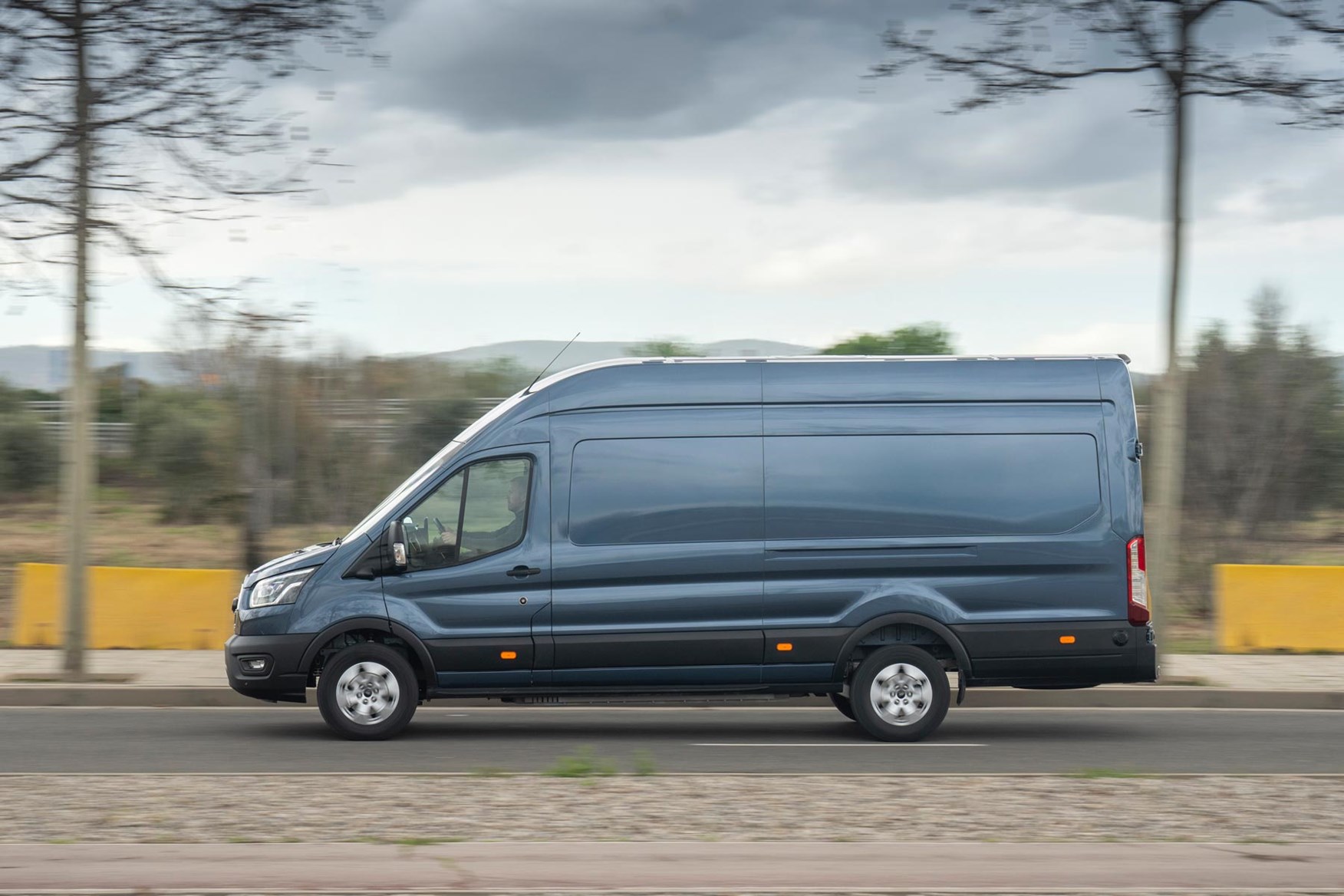
The challenge it faces is that all the other brands are doing the same, which means that there are rivals out there with longer electric ranges
The bigger battery has also heralded an uptick in the E-Transit's fast charging abilities, with it now possible to connect to anything up to a 180kW DC charger, which means you can get from 10-80% in 28 minutes and add approximately 72 miles in 10 minutes. The standard model is still restricted to a 115kW charger, which means the 10-80% is possible in around 37 minutes and you get around 35 miles in 10 minutes.
Outright performance certainly isn’t a problem, as the E-Transit’s electric motor is available with as much as 198kW of power – that’s equivalent to an enormous 269hp. A detuned version with 135kW / 184hp is also available. We've driven both.
More different than it looks
The E-Transit is no simple conversion - it has undergone quite the transformation beneath the surface. There’s a lot more to it than replacing the diesel engine and sticking on a blue grille.
For instance, the electric motor is mounted under the rear of the van, which means the rear suspension has been completely revised as well. New crash structures have been developed to protect occupants and the battery pack.
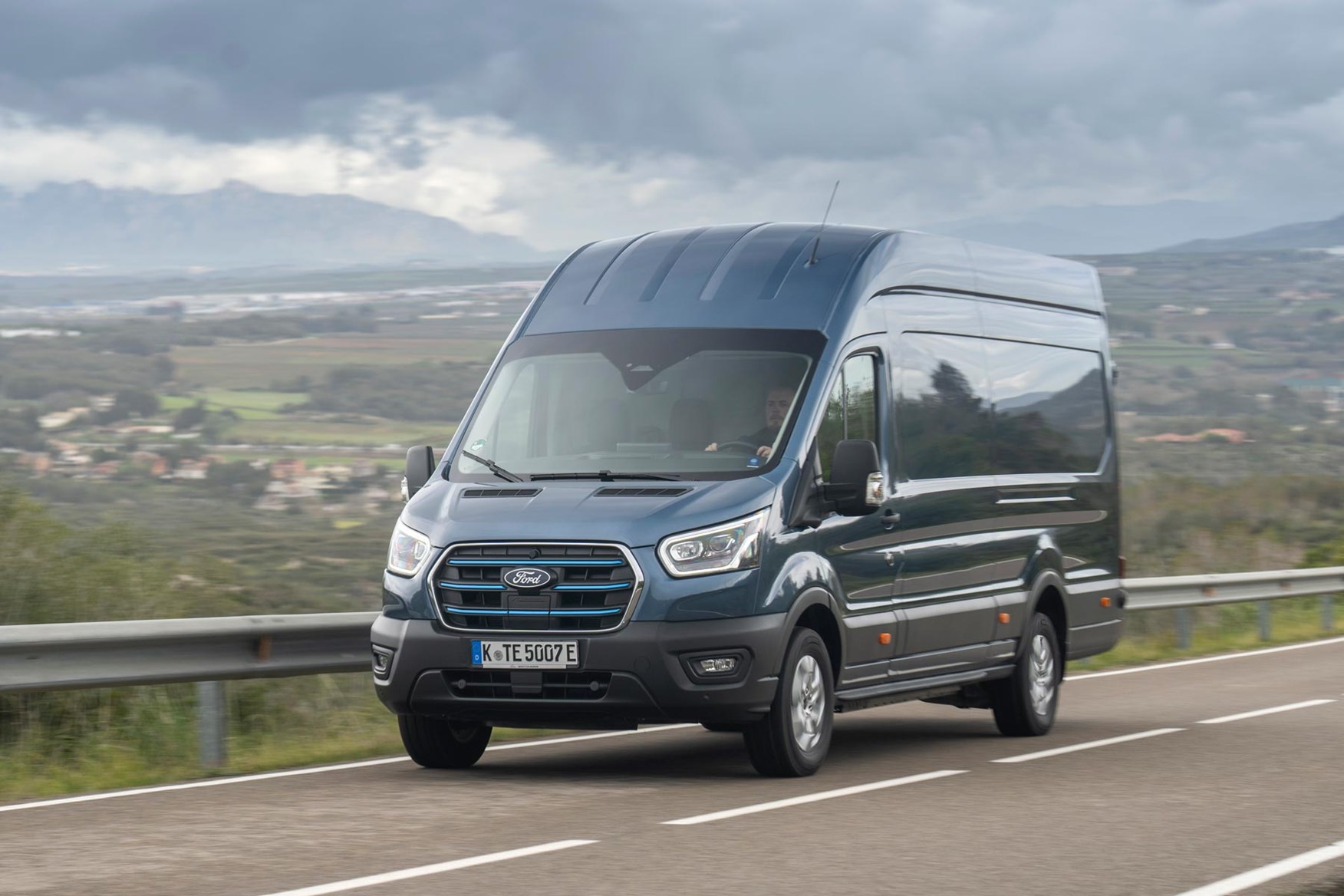
There are many versions available, and it comes in two specifications: Leader (also known as Base) and Trend. Both come with greater standard equipment than the diesel equivalents, with highlight features in the cab including the Ford Sync 4 infotainment system – with a ginormous 12.0-inch touchscreen – and the rotary controller for the single-speed transmission.
Rivals
Ford was one of the last brands to launch a large electric van and while it managed to take its place at the head of the class when it arrived there are now some highly impressive rivals to beat.
The Renault Master E-Tech is top of the pile now, with a superior range, excellent efficiency and a fantastic payload. The Nissan Interstar is almost identical, but also offers a smaller battery should you want to go less far but carry more payload.
The Stellantis family of vans includes the Citroen e-Relay, Fiat E-Ducato, Peugeot e-Boxer and Vauxhall Movano are all joined by the mechanically identical Toyota Proace Max. These all boast huge batteries that provide impressive ranges, but they are still based on dated platforms and they feel their age in various ways.
Then there is the Mercedes-Benz eSprinter, which has the biggest battery of all its rivals at 113kWh, but it doesn't match the others' payloads.
Verdict: is the Ford E-Transit any good?
The rest of this Ford E-Transit review goes into much greater detail, but the short and sweet answer is yes. As of 2025 the answer is more qualified than when it launched, given the strength of the competition, but there is still plenty to push the E-Transit up to the top of your list.
It drives well, has a good level of equipment, offers a competitive if not class leading range and payload combo and has a good cabin. But one of the other crucial factors is the huge ecosystem of support under the Ford Pro banner. Ford is the biggest commercial vehicle brand in the UK and it therefore has the most comprehensive aftersales and servicing programme. Ford Pro can provide everything from financing and telematics to servicing and charging infrastructure. It isn’t exclusively related to electric vans, but it goes a long way towards enabling the transition, whether you’re in the market for one van or hundreds.
Skip to our full verdict on...
- Powerful electric motors mean plenty of performance
- Revised suspension design improves handing and comfort
- Interesting efficiency boosting tech to extend driving range
When it comes to the driving experience, the E-Transit deserves the highest praise we can give an electric vehicle – which is to say it feels every bit as polished as a diesel Transit, and in many respects is even better.
What’s the Ford E-Transit like to drive?
Refinement and performance are both excellent. Most large electric vans suffer from being noisy in the cab and some are very slow, but the E-Transit is quiet and composed at speed and reliably punchy under your right foot even when loaded. That's true for the 184hp, while the 269hp version adds another level of oomph.
For those that are worried what this will mean for unsecured loads, especially at the hands of enthusiastic drivers, the accelerator doesn't give you all that power all at once. Instead it behaves in much the same way as the lower powered version the majority of the time, but if you push the accelerator all the way to the floor then the last little bit of travel gives you an urgent surge of speed, whether you do so from standstill or while moving for an overtake.
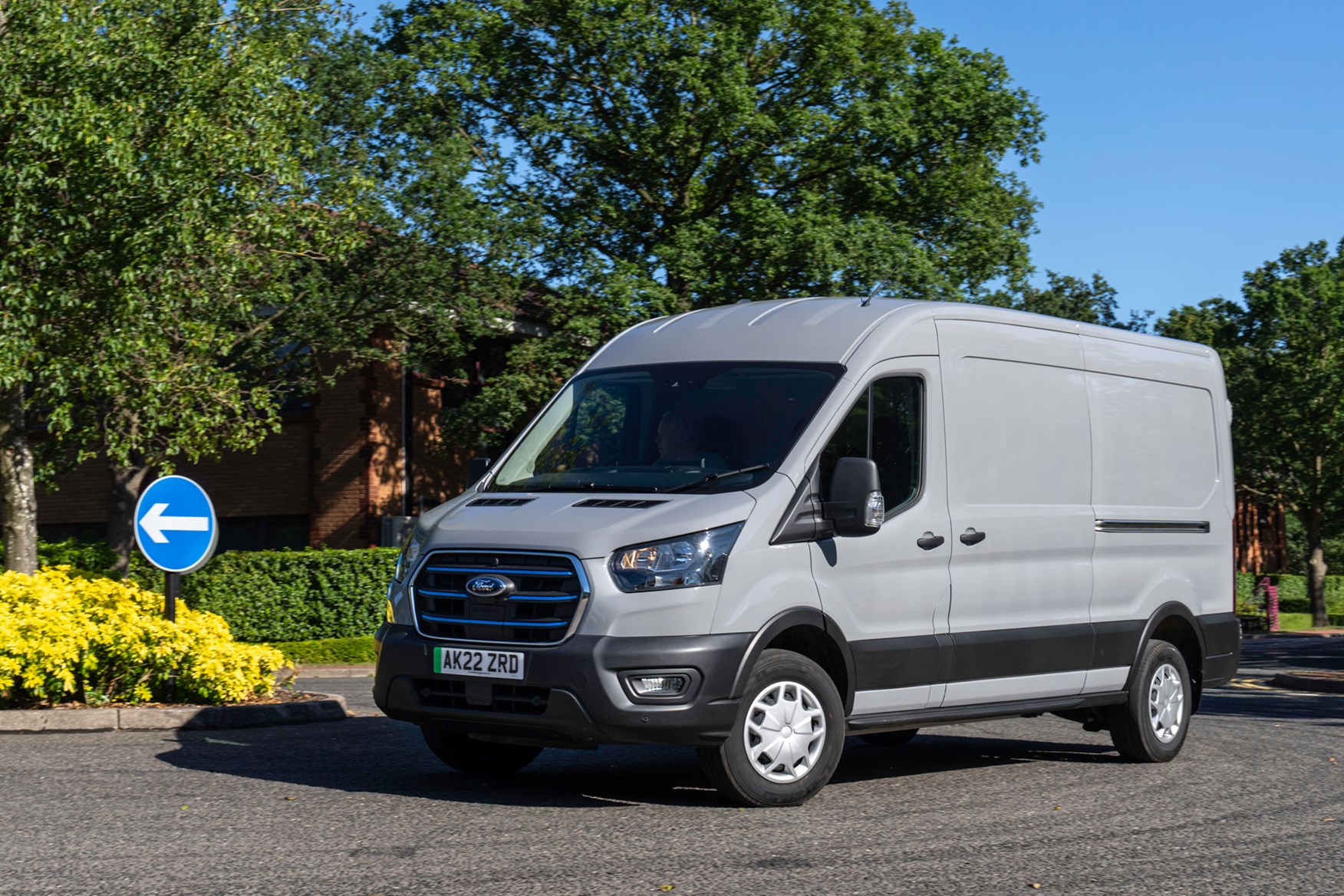
This means that you really have to want to make the most of the 269hp's speed and performance, but it is there when you ask for it. It does feel like it is a 'want' rather than 'need' though, as the 184hp model has enough to make it seem as though it has more power and performance than all its rivals.
When driving there is almost no wind or road noise, all the control weights and responses feel familiar from the diesel versions, and the whole thing exudes a sense of quality and togetherness that you only get from a thoroughly well engineered and tested OEM drivetrain solution.
The single-speed transmission takes the stress out of stop-start traffic – as with all electric vehicles it’s like driving a completely unflappable automatic – while the composure and comfort make the E-Transit feel at home on faster roads and twistier ones as well.
It's worth noting that the larger battery doesn't have an impact on how the Transit drives. It adds a little weight, but not to the extent that it affects dynamics and that will be negated the second you start loading it up anyway.
Independent rear suspension
This composure is helped by the rear suspension, which has been completely reengineered as a result of the need to accommodate the drive motor between the back wheels.
Not only is there a bespoke chunky rear subframe assembly, you also get independent coil springs in place of the diesel’s live axle and leaf spring setup.
Combine this notably improved ability to handle bumps with the reduced centre of gravity created by the position of the battery pack beneath the load floor, and you’ve got a crisp, nimble-feeling large van that’s very surefooted and doesn’t roll around too much in the turns.
Unladen, the van can be a little bouncy. But even a small amount of payload quickly calms this down, making the E-Transit pleasant and easy to live with.
Unusual regenerative braking system
As with other electric vans, the E-Transit can recover energy to recharge the batteries every time you lift your foot off the accelerator. The transmission can be put into an L mode in order to heighten this effect, though even with this engaged it’s a far cry from the ‘one pedal’ driving available in some electric vehicles, where lifting off can bring them to a swift and smooth total stop.
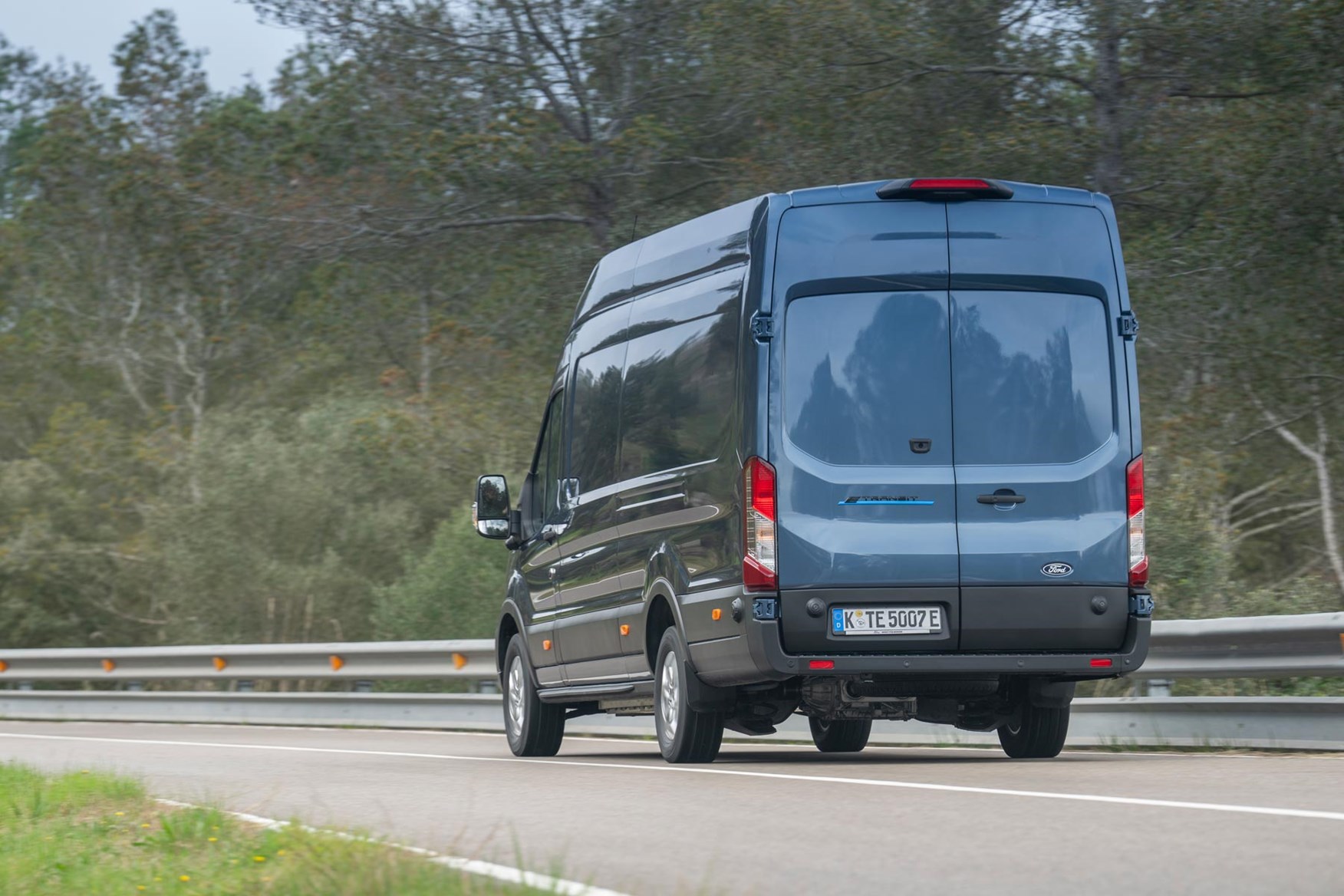
Some EVs go further by adding paddles to the back of the steering wheel that can control the level of regenerative braking. Ford has chosen a more unusual route.
If you find yourself wanting to slow down a little faster than the normal driving mode, a single tap on the brake pedal activates a regen mode halfway between the regular Drive setting and the more pronounced L setting; two taps matches the L mode, but doesn’t engage it permanently – the van reverting to the standard setting as soon as you begin accelerating again.
This all works as it should – once you’ve got used to the process. But we can’t help thinking it’s a rather fussy, unnatural approach compared with a set of paddles. Something that requires a period of adjustment before you manage to make the most of it, we suspect.
On-board driver coaching
Speaking of making the most of it, the E-Transit has a couple of on-board features to help drivers maximise their own efficiency and therefore the van’s potential driving range.
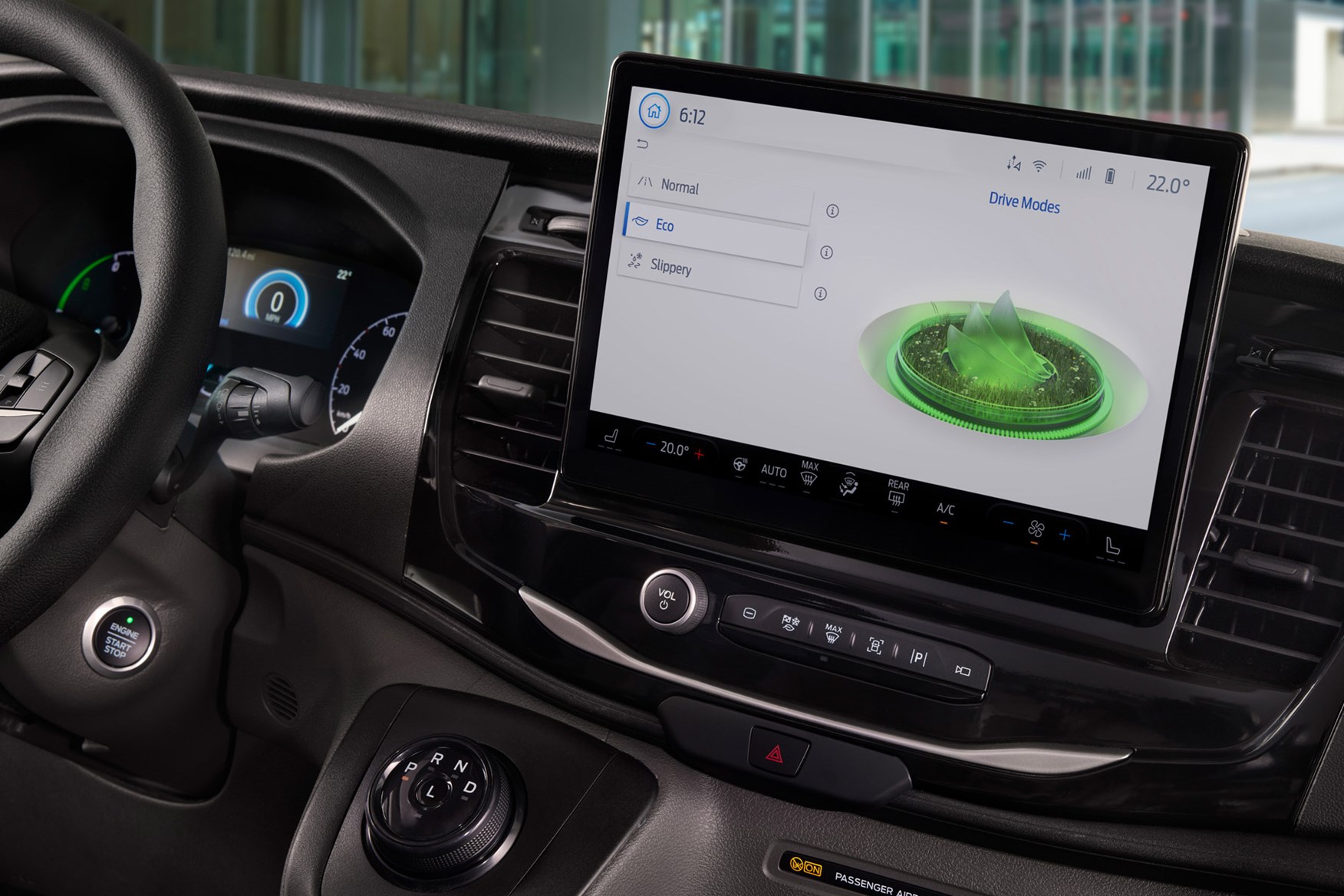
The most obvious is on the central touchscreen, where a set of percentage bar graphs give you real-time feedback on how efficiently you’re managing acceleration, deceleration and speed. There is also a choice of three driving modes: Normal, Eco and Slippery. The little button might have a chequered flag on it, but it doesn't have a Sport mode though.
Going further than this, however, if you do something abrupt or repeatedly inefficient, the van can also offer spoken guidance on ways to improve. We have accidentally activated this while testing out the brake-tap regeneration system in the past. Which is mildly ironic.
- Huge central touchscreen
- Excellent quality throughout
- EV-specific features are easy to understand
The Transit already has one of the nicest large van interiors, with material quality and design a step well ahead of most rivals. The E-Transit offers the latest Sync 4 infotainment system, however, which adds a massive 12.0-inch central touchscreen.
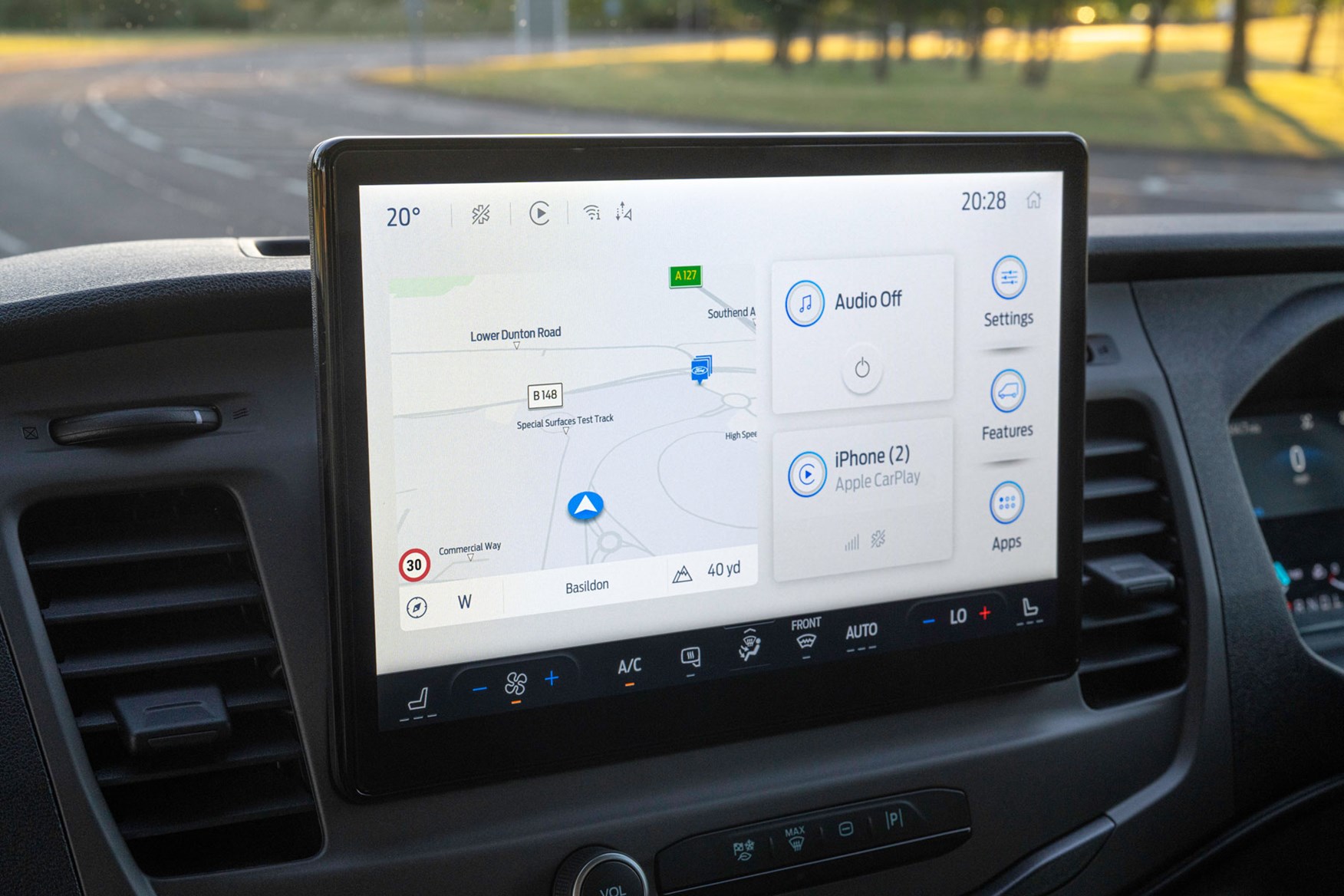
Other changes around the cab include the gearlever being replaced by a rotary dial to control the single-speed transmission, and the absence of a conventional manual handbrake. This has been replaced by an electronic handbrake, activated by a switch below the steering wheel.
The instrument cluster also gets a minor change, as the rev counter is swapped by a power-use indicator – which also helps you understand when the batteries are recuperating energy via the brake-regeneration process mentioned in the driving section above – and the fuel gauge now shows battery level.
Remaining driving range is also indicated in distance (miles or kilometres), albeit in the form of a small digital numbers at the bottom of the trip computer screen. There are other new display options within this as well, including info about how many kilowatts (kW) you’re using to cover a set distance, which is a useful way of measuring and comparing electric van efficiency.

Ford Sync 4 is very impressive in use, quick to respond and easy to navigate if you have any familiarity with tablet computers or smartphones – though having all the ventilation controls integrated into the touchscreen does mean you’ll have to pay a little bit more attention to how you adjust the temperature and so on. Taking that attention away from the road.
Ford E-Transit Pro Power Onboard
An optional upgrade for the electric Transit, Pro Power Onboard allows you to use the 68kWh drive battery to power electric equipment.
There are three plugs – one in the cab, two in the load area – and it delivers up to 2.3kW, enough juice to run a selection of tools but not power a house (something the American-market Ford F-150 Lightning electric pickup truck can do, thanks in part to its much larger battery pack).
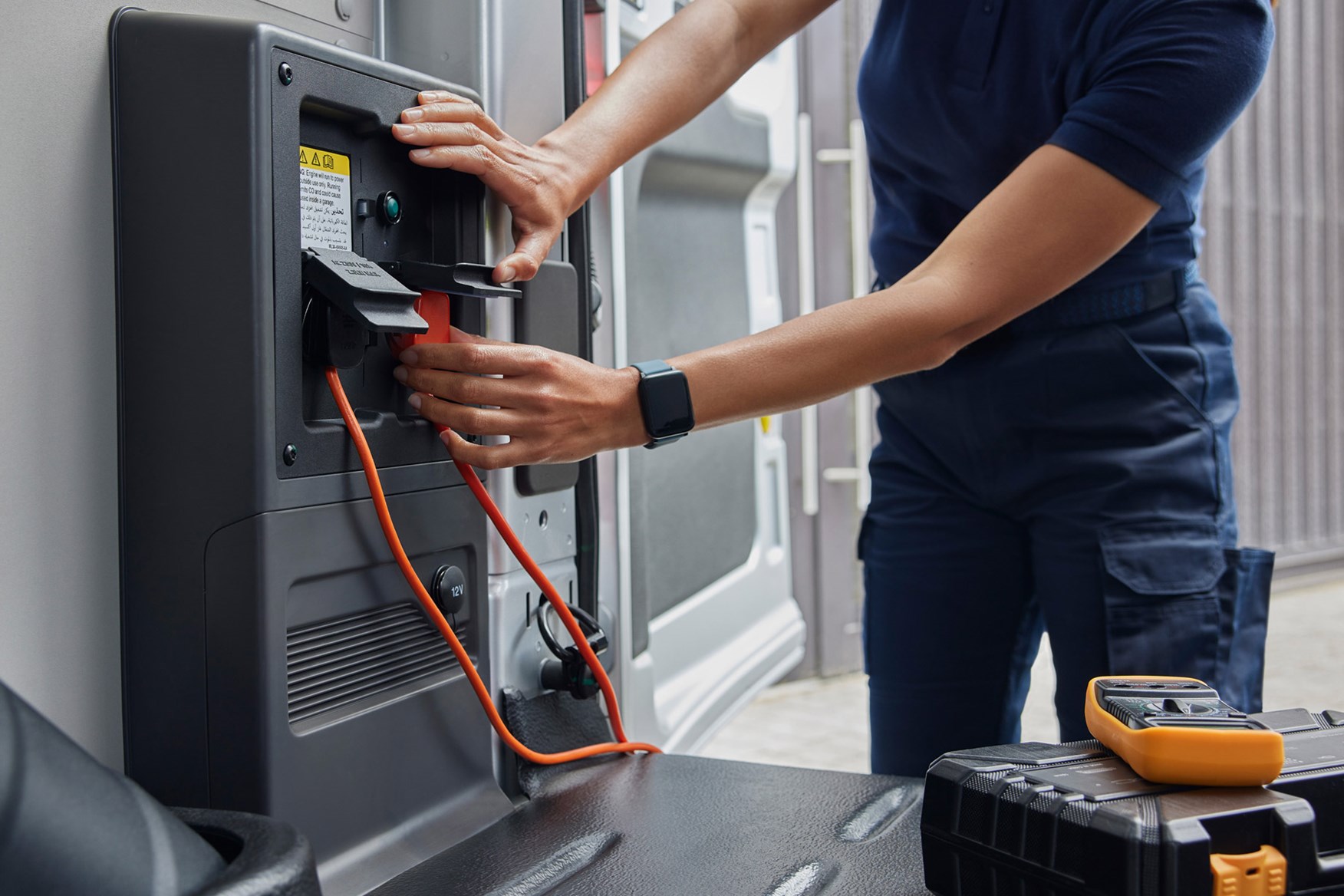
And don’t worry, the van is smart enough to shut things down before you get stranded, and it will warn you ahead of time so you’re not cut-off mid work job. You can even select the amount of driving range you need to retain before the shut down happens, with that range based on your own real-world driving data.
- Should be cheaper to run than a diesel
- Well equipped as standard
Inevitably the E-Transit pricing has risen since it first launched, and the entry-level model starts at just over £51,000 (not including VAT). This is arguably a lot for a van but it is fairly standard for an electric van, as rivals like the Vauxhall Movano are comparably priced. The Renault Master E-Tech, though, is priced lower. Don't forget to factor in the UK government plug-in van grant, too.
The cost per mile rate of running the E-Transit will vary with your electricity tariff, and how you charge it; the public charging network will be much more expensive than doing so at home or back at base. If you choose wisely, however, you should still find the same distance cheaper in one of these than it would be in a diesel van.
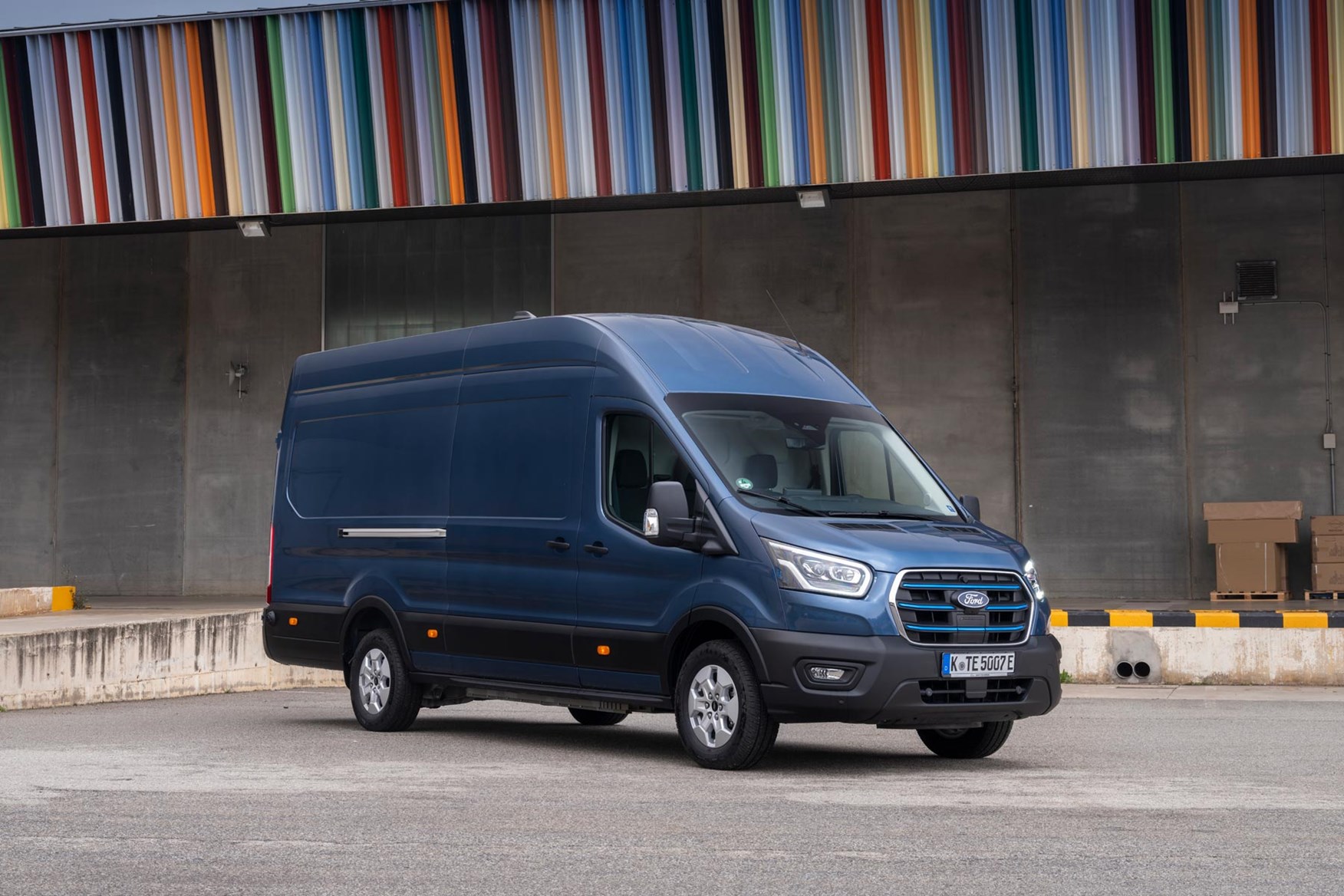
On top of this, servicing costs are lower – there are fewer moving parts to worry about – and consumables such as brake pads and discs should last longer if you make the best possible use of the regeneration process.
Ford E-Transit service intervals
Speaking of servicing, Ford’s taken an unusual step of introducing unlimited mileage service intervals for the E-Transit. In 2025, Ford also extended the service intervals from one year to two.
Ford E-Transit warranty
All the regular bits of the E-Transit are covered by the same three-year warranty as any other Transit. The electric drive components get a longer eight-year / 100,000 mile warranty, for added reassurance.
Ford E-Transit standard equipment
The E-Transit comes in just two trim levels: Leader and Trend. Both have slightly more standard equipment than the equivalent diesel models, which also gets the higher Limited version.
Ford E-Transit Leader standard equipment highlights:
- Semi-automatic air conditioning
- Powered, heated door mirrors
- Heated windscreen
- 12.0-inch infotainment display with Sync 4
- DAB radio
- Android Auto
- Apple CarPlay
- Electric parking brake
- Keyless start
- Metal bulkhead
Ford E-Transit Trend standard equipment highlights (in addition to Leader):
- Satellite-navigation
- Moulded load-floor liner
- Cruise control
- Front and rear parking sensors
- Automatic wipers
The Trend also has an increased number of standard safety features, detailed in the safety section below.
The E-Transit has started life promisingly on the reliability front with only a minor recall in its first few years of life. The electric version doesn't get separated out in our list of the most reliable vans, but the Transit is a regular feature in the top 10. This is a proper, large-scale production model, not a third-party conversion, too, which helps minimise the areas of potential issue.
Electric vans have fewer moving parts than diesel models, and electric vehicles are typically highly reliable. So we’re not expecting any major problems here. If there are, then Ford Pro's service offer is wide ranging, with mobile service vans and remote assessment a part of that to help minimise downtime.
- Trend model leads the way for safety items
- Platinum Euro NCAP rating
Safety equipment for the Leader model was relatively limited when the E-Transit first launched, but this has since been stepped up as Ford aimed for a high Euro NCAP score. It has managed to get that, being named one of the safest vans by being awarded a Platinum rating in 2024. This is thanks to the standard fitment of kit including electronic stability control, side-wind assist, a Collision Mitigation System, Speed Sign Recognition, Lane Departure Warning and a Lane Keeping Aid.
A vast number of additional active safety aids are available via the options list, including usefully practical things such as 360-degree monitoring systems and a permanent digital rear-view camera.
Both electric versions feature additional crash structures. Some to protect the batteries, others to replicate the structural role played by the engine that used to be under the bonnet; this area is now used to house a lot of the van's control systems.
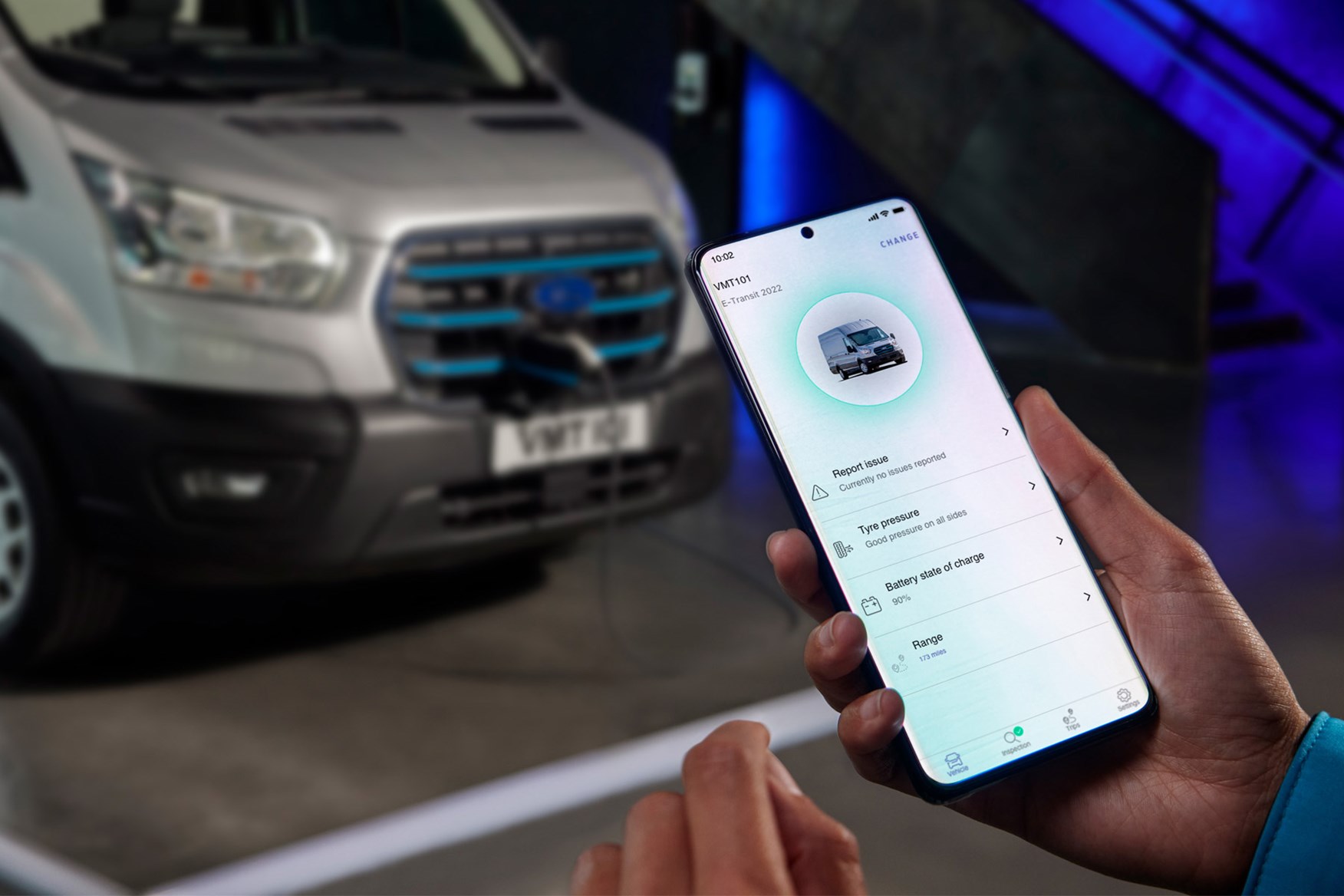
As for van security, standard features aren’t super impressive but Ford offers a huge range of upgrades, especially in terms of locks. It also has some very clever electronic systems available, including fleet management capability via Ford Pro and the FordPass Pro app for smaller fleets and single vehicles.
This has helped van owners locate their stolen vehicles, assisting the police in the process of reclaiming their possessions.
Which Ford Transit E-Transit is best for me?
The E-Transit comes in a wide range of different variants, so you’ve got some thinking to do here.
Ford is a rarity in the electric van sector by offering more than one power option, but the 184hp variant will be more than adequate for most buyers. The 269hp seems more of an indulgence than something that adds extra usability.
Both trim levels are well equipped, but you certainly get a useful number of extras for your money by upgrading to Trend, so we’d certainly be tempted to do that.
Body size will be down to how much load volume you need versus how much payload – the larger the van, the less weight it can carry.
Finally, you can now choose between two battery packs, with the Enhanced Range promising a decent upgrade on the original's electric capability, but with the compromise of a lower payload. To mitigate this, you can get the E-Transit with multiple gross vehicle weights, including a 3.9-tonne and 4.2-tonne version. Both of these can be driven on a standard licence, though, thanks to a change in the law that lets Category B licence holders get behind the wheel of a heavier electric van.



